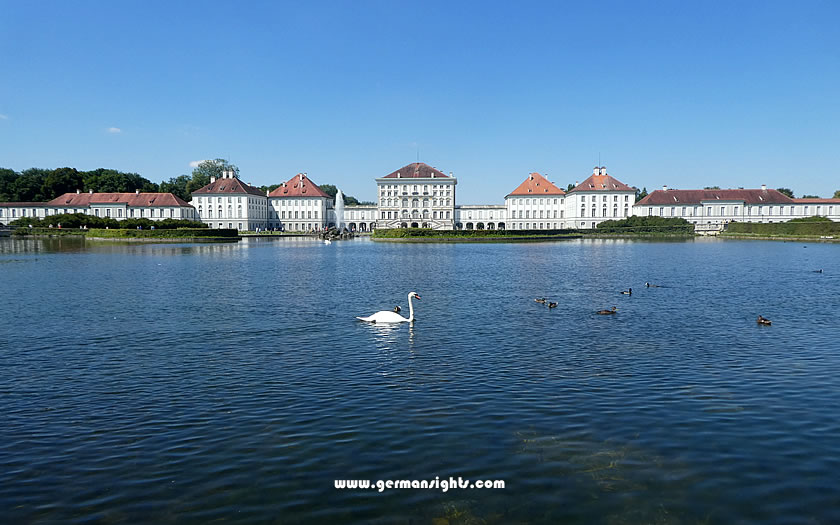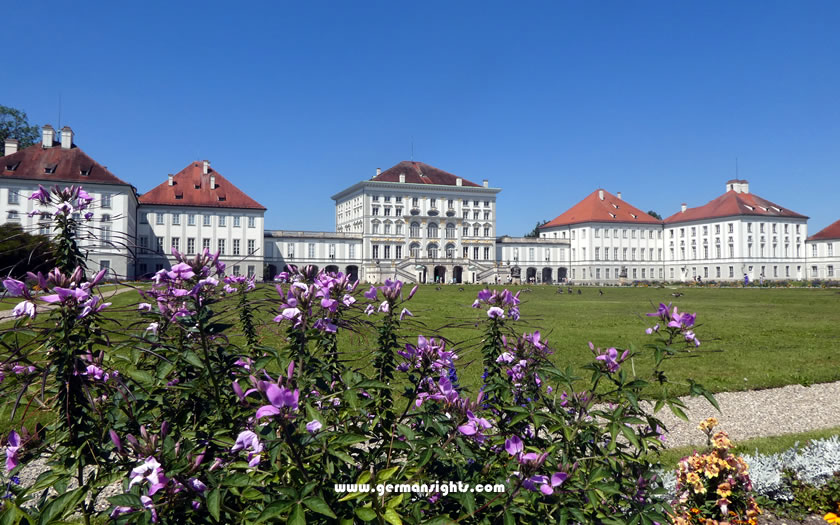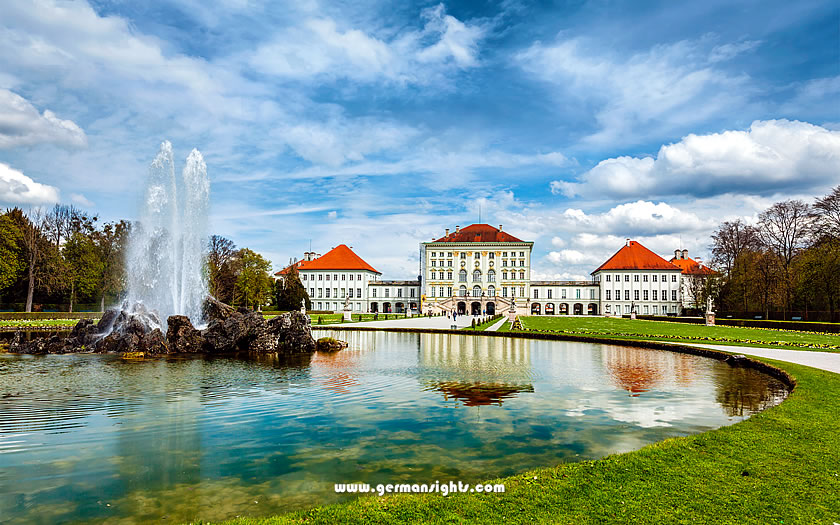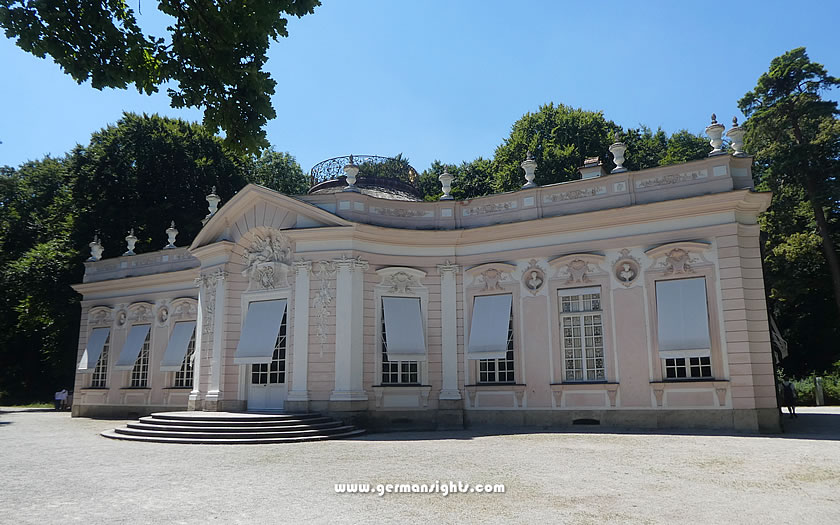Nymphenburg Palace is a former summer residence of the Bavarian rulers in Munich.
It was founded in 1664 by Elector Ferdinand Maria and his wife Henriette Adelaide of Savoy to celebrate the birth of their son Max Emanuel.

Nymphenburg Palace in Munich
The palace was expanded and remodeled several times over the centuries, especially by Max Emanuel and his successor Karl Albrecht, who hired French and Italian architects and artists to create a magnificent baroque complex.
Schloss Nymphenburg is located in the northwest of Munich, between the suburbs of Pasing and Neuhausen.
Work started on Schloss Nymphenburg in 1664. It was remodelled many times up until the 19th century.
Elector Ferdinand Maria and his wife Henriette Adelaide of Savoy had the palace built to celebrate the birth of their son Max Emanuel. He subsequently created much of the palace that we see today.
Schloss Nymphenburg is just over six kilometres from Marienplatz in Munich city centre.
The closest S-Bahn station is at Laim, which is around one-and-a-half kilometres from the palace. Laim is a stop on many of the central S-Bahn lines. The closest underground stations are Gern and Rotkreuzplatz on the U1 line.
Nymphenburg Palace is a magnificent baroque palace in Munich, Germany, that served as the summer residence for the rulers of Bavaria from the House of Wittelsbach.
The palace was built in several stages, starting from 1664, and reflects the changing tastes and ambitions of the Bavarian electors and kings.
The palace was commissioned by Elector Ferdinand Maria and his wife Henriette Adelaide of Savoy to celebrate the birth of their son and heir, Maximilian II Emanuel, in 1664.
They hired the Italian architect Agostino Barelli to design a cubic pavilion with a court church and a small garden. The palace was mostly completed by 1679, but it was still modest in size and style compared to other European courts.

Schloss Nymphenburg main palace
Maximilian II Emanuel, who became elector in 1679, expanded the palace significantly to reflect his status and power.
He hired the court architect Enrico Zucalli to add two pavilions on each side of the central building, connected by galleries. He also enlarged the garden and added several pavilions and fountains.
However, his involvement in the War of the Spanish Succession forced him to leave Bavaria in 1704 and halted the construction work until his return in 1715.
After his return, Maximilian II Emanuel continued to embellish the palace with the help of Joseph Effner, a new court architect who introduced the French rococo style.
Effner redesigned the central pavilion, decorated the royal apartments, rebuilt the annexes as residences for court officials, and constructed a crescent-shaped wall with five pairs of pavilions. He also collaborated with the French landscape architect Dominique Girard to create a grand canal and a cascade in the garden.

Nymphenburg Palace park
The palace remained a favorite residence of the Bavarian electors and kings in the 18th and 19th centuries.
Elector Charles Albert, who became Emperor Charles VII in 1742, added a wing for his wife Maria Amalia and commissioned François de Cuvilliés to create the exquisite Amalienburg hunting lodge in the park.
His son and successor, Maximilian III Joseph, built the Pagodenburg tea house and the Badenburg bath house. He also invited artists like Johann Baptist Zimmermann and François de Cuvilliés the Younger to decorate some of the rooms with frescoes and stucco.
When Bavaria became a kingdom in 1806, Nymphenburg Palace underwent some changes to adapt to the new political situation.
King Maximilian I Joseph ordered some of the rooms to be furnished in the neoclassical style and commissioned landscape gardener Friedrich Ludwig von Sckell to transform the French palace garden into an English version.
His grandson, King Ludwig II, who is famous for building Neuschwanstein Castle, was born at Nymphenburg Palace in 1845.
Today, Nymphenburg Palace is one of the most popular tourist attractions in Munich and one of the finest examples of baroque architecture in Germany.
It houses several museums, such as the Marstallmuseum (Carriage Museum), the Porzellanmuseum (Porcelain Museum), and the Museum Mensch und Natur (Museum of Man and Nature).
Nymphenburg Palace is one of the most impressive and beautiful attractions in Munich.
You can take public transport from the city centre to get to Nymphenburg Palace. Both S-Bahn and U-Bahn stations are within walking distance (see information in the Quick Facts section above), while confident travellers can also try the local bus and tram services, such as tram 17 from Karlsplatz to Schloss Nymphenburg.
Website: www.mvv-muenchen.de
The palace is open daily, with slightly restricted times in the winter months. The admission fee varies depending on what you want to see. You can buy single entrance tickets for some attractions, such as the main palace, but a combination ticket that includes the palace, the carriage museum, and the park palaces is also available. Children under 18 are free.
The main palace consists of a central pavilion and two wings connected by galleries. The central pavilion houses the royal apartments, which are decorated with lavish furniture, paintings, frescoes, and stucco.
Some of the highlights are the Great Hall, with its ceiling fresco by Johann Baptist Zimmermann depicting the four continents; the Gallery of Beauties, with portraits of 36 women commissioned by King Ludwig I; and the Birth Room of King Ludwig II, the famous builder of Neuschwanstein Castle.
The carriage museum (Marstallmuseum) is located in the south wing of the palace. It displays a collection of carriages, coaches, and sleighs used by the Bavarian rulers.
The most extravagant ones are the coronation and state coach of King Ludwig II, which looks like a fairy tale carriage; and the Hercules sleigh of Elector Max Emanuel, which is the oldest in the collection.
Nymphenburg Palace park itself is a masterpiece of landscape design, covering an area of 200 hectares (494 acres).
It was originally a French formal garden, but was later transformed into an English landscape garden by Friedrich Ludwig von Sckell. The park features a grand canal, a cascade, several fountains, statues, bridges, temples, and a botanical garden.

The Amalienburg in Nymphenburg park
The park palaces (Parkburgen) are small buildings scattered around the park that were used for various purposes by the royal family.
They include the Amalienburg, a rococo hunting lodge with a circular hall and a kennel for hunting dogs; the Badenburg, a bath house with a large pool and a Chinese cabinet; the Pagodenburg, a tea house with oriental motifs; and the Magdalenenklause, a hermitage with an artificial ruin.
Note that the park palaces are closed in the winter months.
Website: www.schloss-nymphenburg.de
If you know when you are planning to go but haven't decided on accommodation, then use the map below to get an idea of which properties are available and to compare prices during the period you wish to travel.
Enter your proposed dates and use the '+' to zoom in on a location and reveal more properties. Click on the price above a property to see more information.